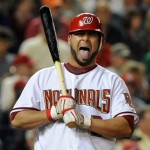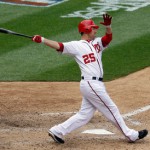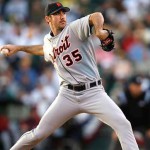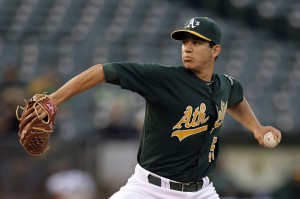
Tyler Clippard faces what could be a very interesting arbitration case this offseason. Photo Jonathan Newton/wp.com
Once the dust settled on this year’s Super-2 cutoff (and we discovered that Drew Storen will be arbitration eligible this year while Ryan Perry will not), the Nats will have no less than TEN arbitration-eligible players this off-season, setting the stage for some non-tender decisions, some possible contract extensions, and (hopefully not) some arbitration cases. The Non-tender deadline isn’t until November 30th, but its never too soon to talk about what the team may do.
Here’s the 10 players eligible, a discussion as to what kind of salary they may obtain and whether or not the team will even tender a contract. Note: the salary estimates are from mlbtraderumors Matt Swartz‘s arbitration projections model, with my own thoughts adjusting up or down based on opinion and noted as such). Arbitration salaries essentially try to project the full FA value of a player and then award 40%/60%/80% of that FA salary in each of the three typical arbitration years. For guys getting a 4th, I generally assume they’re getting nearly 100% of their FA value in the last year.
Locks to get a Contract Tender
- Ian Desmond. 1st year Eligible/$3.2M estimate: Breakout season in 2012 will earn him plenty of dollars in his first and subsequent arbitration cases. $3.2M equates to nearly a $10M/year full FA value, probably fair for now but could escalate if Desmond continues to provide Gold Glove calibre defense to go along with middle-of-the-order power. It may be slightly early to think about a longer-term contract extension for Desmond; I’d want to wait and see if his 2012 production continues into 2013. Remember; he’s just one year removed from a time when most Nats fans wanted him replaced.
- Drew Storen: 1st year Eligible/$1.7M estimate: Storen will get a 4th year of eligiblity by virtue of a quick call-up after getting drafted. $1.7 over 4 arb years equates roughly to a FA value of $7M/year, which seems a bit low for a good closer. I’d guess Storen could get slightly more money, though the team probably argues that his injuries in 2012 prevented him from giving full value, and is probably why he’s estimated at $1.7 instead of nearer to the $4M that Chad Cordero got his first arb year with this team. Rizzo has dangled Storen in trade talks in the past, but seems likely to keep him (at the possible expense of Clippard) for the coming season.
- Craig Stammen: 1st year Eligible/$900k estimate: Another super-2 guy who was incredibly valuable to the team this year. I’d guess he’ll get more than 900k despite his role as a middle reliever, since 900k is barely more than the typical veteran minimum (which is roughly $800k, what Mark DeRosa made in 2012). Though, 900k equates to roughly a $3.5M FA value, which seems high for the kind of middle relief right-hander that are a dime a dozen in this league. I’d guess Stammen is the right kind of guy for the team to buy out a couple of arbitration years, much as they did with Sean Burnett a couple years ago. But, being a fungible middle-relief arm, don’t look for anything other than a 2 year deal so the team is protected in case of injury.
- Jordan Zimmermann: 2nd year eligible, $4.9M estimate: Another super-2 guy who will get a 4th year of arbitration, this estimate also seems low considering the season that Zimmerman just put in. It also roughly equates his FA value at roughly $10M a year, which I’d guess is also undervaluing Zimmermann. Ask yourself; if he was on the open market, you’d have to think he’s getting more than $10M/year (point of comparison: Kyle Lohse turned down a 13.3M qualifying option and may get 4/60; who would you rather have?)
- Tyler Clippard: 2nd year eligible, $4.6M estimate: I see this estimate as high frankly, as being too much of a raise over his 2012 salary of $1.625 despite his being the closer most this year. Clippard said it himself; its better to be the closer, get the saves and get the salary. But $4.6M for a setup guy is way too hefty. If Clippard comes in this high with his demand, look for an ugly arbitration hearing. Honestly, I could see Clippard being a trade candidate and making this arbitration decision someone else’s headache, and the team goes into 2013 with Storen firmly entrenched as the closer with the likes of Mattheus, Garcia and Henry Rodriguez vying for the 8th inning role.
- Ross Detwiler: 1st year eligible, $2.2M estimate: This seems right in line with what Jordan Zimmermann got last year ($2.3M in his first eligible year). A successful young starter going through this process the first time.
- Roger Bernadina: 1st year eligible, $1.1M estimate: A year ago I thought Bernadina was going to get DFA’d at the end of spring training. Now I wonder if he’s got enough value to be flipped in trade after a standout season for this team as its 4th outfielder. $1.1m is very reasonable for a 4th outfielder with his defensive skills, so don’t be surprised to see Bernadina remain in this role with the team for several years.
Most likely Non-Tender candidates
- Jesus Flores: 4th year eligible, $1.2M estimate. Flores represents an interesting test case. Clearly he no longer has a 25-man catcher spot, having fallen behind both Wilson Ramos and Kurt Suzuki on the depth chart. The team also has shown itself to have decent rising catcher depth in the likes of Sandy Leon and Jhonatan Solano. And Flores really regressed this year both offensively and defensively, so much so that the team had to go out and acquire Suzuki late in the season. So I completely understand those that think that Flores is a non-tender candidate. BUT, you don’t just cut loose valuable commodities, and a healthy catcher who can serve as a backup in the majors is still worth keeping. That being said (as I reported in an earlier post), Flores seems to have achieved 5 service years, meaning that despite his option availability he’d have to agree to be assigned to AAA. Which means his flexibility is completely compromised for this team in 2013. The only remaining reason to sign him would be as insurance in case Suzuki or Ramos get hurt in spring training. If he doesn’t get traded in the next two weeks, look for a non-tender.
- Tom Gorzelanny: 4th year eligible, $2.8M estimate. I’m not sure I agree with the MLBtraderumor estimate here, because the likelihood of players getting pay DECREASES in arbitration is pretty slim. Its not like Gorzelanny posted a 6.00 ERA in 2012 after all. Gorzelanny made $3M in 2012, where he predominantly served as our long-man/mop-up guy out of the pen. The question the team has to ask itself is this; is $3M too expensive for the last guy out of the pen? I believe it is, and thus I believe Gorzelanny is destined to get non-tendered. I believe the team likes him but his salary isn’t matching up to his role any longer, so I see him being forced to take a significant salary cut if he wanted to stay here. Were I the Nationals, I’d rather take a shot at a MLB-minimum guy (or even a rule-5 guy) in that mop-up role. The only thing that gives me pause in declaring that the team is ready to cut ties with a lefty reliever is the apparent sky-high cost of lefty relievers on the market; Jeremy Affeldt just signed a 3 year $18M deal to stay with San Francisco. Would this contract convince the Nats management that perhaps Gorzelanny is a player worth hanging on to?
- John Lannan: 3rd year eligible, $5M estimate. There are two schools of thought with Lannan in the Natmosphere right now. One group believes that the team will let Edwin Jackson walk, Lannan will naturally take his place as the 5th starter and the team won’t pursue any starter talent in trade or in free agency. The other school of thought (and the one to which I subscribe to) states that Mike Rizzo values power arms and doesn’t rate Lannan at all, that $5M (which I think is a low estimate if he were to actually reach arbitration) is far too expensive for a soft-tossing 5th starter, and that the team will be actively searching for a 5th power arm to replace Jackson in the rotation. I think the team would rather take that $5M+ and use it to pay an acquisition versus continuing to fund Lannan’s sub 100 ERA+ exploits. This opinion ignores the rising cost of lefty starters, and the relative dearth of quality starts on the FA market, so perhaps the Nats hang on to him one more year.
Having so many arbitration eligible guys means that the Nats payroll will take a significant hit. Assuming that the team tenders the above 8 players (including Flores), here’s what the payroll implication will be:
| Player | 2011 salary | 2012 estimate |
| Desmond | $512,500 | $3,200,000 |
| Storen | $498,750 | $1,700,000 |
| Stammen | $485,000 | $900,000 |
| Zimmermann | $2,300,000 | $4,900,000 |
| Clippard | $1,650,000 | $4,600,000 |
| Detwiler | $485,000 | $2,200,000 |
| Bernadina | $493,500 | $1,100,000 |
| Flores | $815,000 | $1,200,000 |
| subttl | $7,239,750 | $19,800,000 |
| Gorzelanny | $3,000,000 | $2,800,000 |
| Lannan | $5,000,000 | $5,000,000 |
The team needs to plan on paying more than twice it did in 2013 for the services of the top 8 arbitration eligible players in 2012. Most of that money can be made up by non-tendering both Gorzelanny and Lannan … except that those players would need to then be replaced on the roster. Still, getting these 8 players for less than $20M a year while the Yankees owe Alex Rodriguez $28M for 2013 alone sort of puts things in context. It is a good problem to have, having to pay your arbitration-eligible stars more and more each year.




